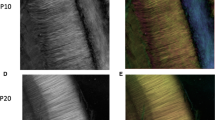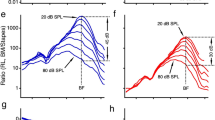Abstract
The three-dimensional fibrillar arrangement of the basilar membrane in the mouse cochlea was studied using scanning electron microscopy. Fibrils of the basilar membrane were exposed by removing cellular elements of the cochlea using a sodium hydroxide maceration technique. The arrangement of fibrils in the basilar membrane was different between the pars arcuata and pars pectinata. In the pars arcuata, fibrils were arranged in radial and spiral direction, showing a woven pattern. In the pars pectinata, most of the fibrils ran in the radial direction. These findings suggest that the vibration pattern of the pars arcuata and pars pectinata is different when the basilar membrane vibrates.
Similar content being viewed by others
References
Bohne BA, Carr CD (1979) Location of structurally similar areas in chinchilla cochleas of different length. J Acoust Soc Am 66:411–414
Cabezudo LM (1978) The ultrastructure of the basilar membrane in the cat. Acta Otolaryngol (Stockh) 86:160–175
Guild SR (1927) The width of the basilar membrane. Science 65:67–69
Iurato S (1967) Basilar membrane, spiral limbus and spiral ligament. In: Iurato S (ed) Submicroscopic structure of the inner ear. Pergamon Press, London, pp 61–66
Katori Y, Hozawa K, Kikuchi T, Tonasaki A, Takasaka T (1993) Fine structure of the lamina basilaris of guinea pig cochlea. Acta Otolaryngol (Stockh) 113:715–719
Kushida H (1961) A styrene-methacrylate resin embedding method for ultrathin sectioning. J Electron Microsc (Tokyo) 10:16
Low FN (1962) Microfibrils: fine filamentous components of the tissue space. Anat Rec 142:131–137
Mikuni H, Ushiki T, Abe K, Fukuda S, Inuyama Y (1994) Nature of the fine fibrils of the basilar membrane in the cochlea. Arch Histol Cytol 57:187–191
Ohtani O (1987) Three-dimensional organization of the connective tissue fibers of the human pancreas. A scanning electron microscopic study of NaOH treated tissues. Arch Histol Jpn 50:557–566
Ushiki T, Ide C (1990) Three-dimensional organization of the collagen fibrils in the rat sciatic nerve as revealed by transmission and scanning electron microscopy. Cell Tissue Res 260:175–184
Von Békésy G (1960) Cochlear mechanics. In: Weber EG (ed) Experiments in hearing. McGraw-Hill, New York, pp 401–534
Weber EG (1938) The width of the basilar membrane in man. Ann Otol Rhinol Laryngol 47:37–47
Author information
Authors and Affiliations
Rights and permissions
About this article
Cite this article
Mikuni, H., Fukuda, S., Küçük, B. et al. The three-dimensional fibrillar arrangement of the basilar membrane in the mouse cochlea. Eur Arch Otorhinolaryngol 252, 495–498 (1995). https://doi.org/10.1007/BF02114759
Received:
Accepted:
Issue Date:
DOI: https://doi.org/10.1007/BF02114759




